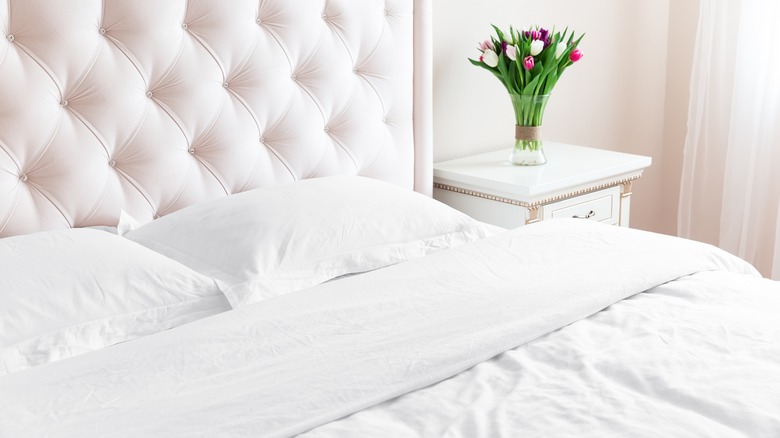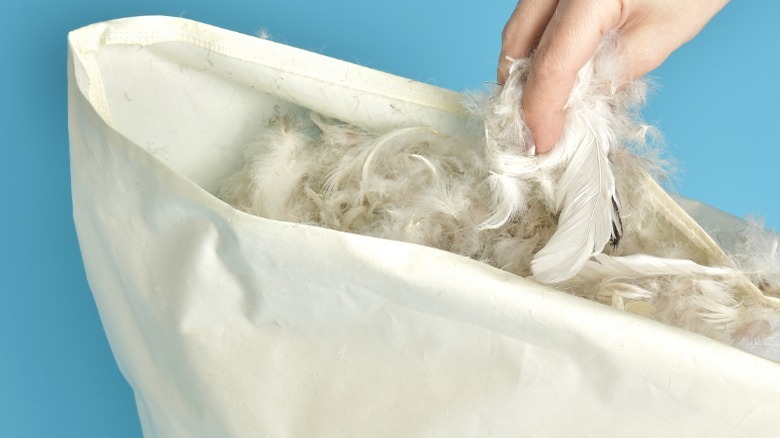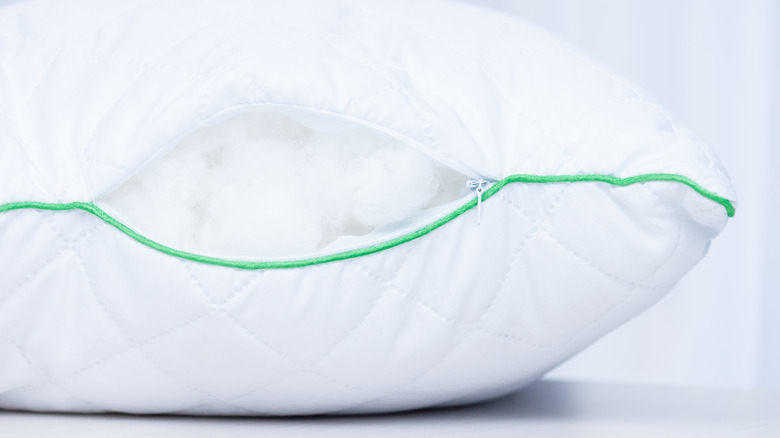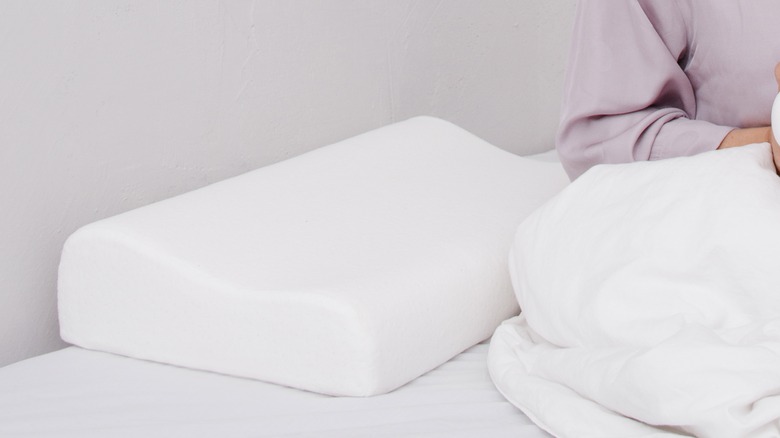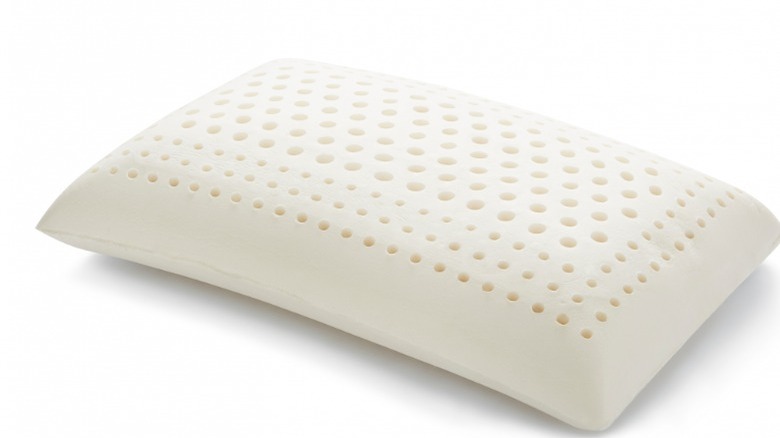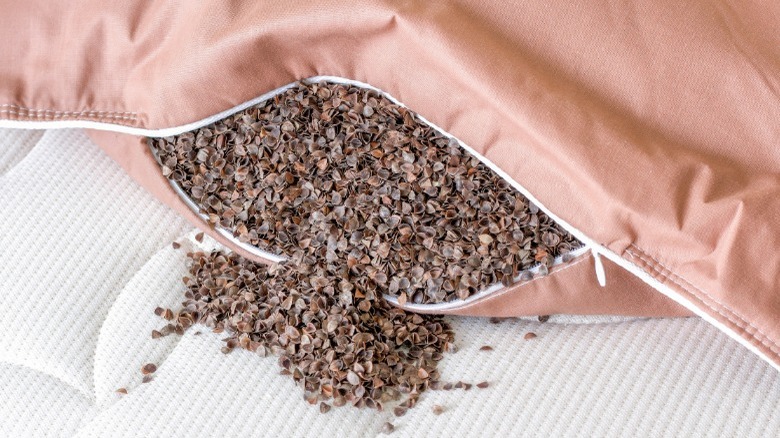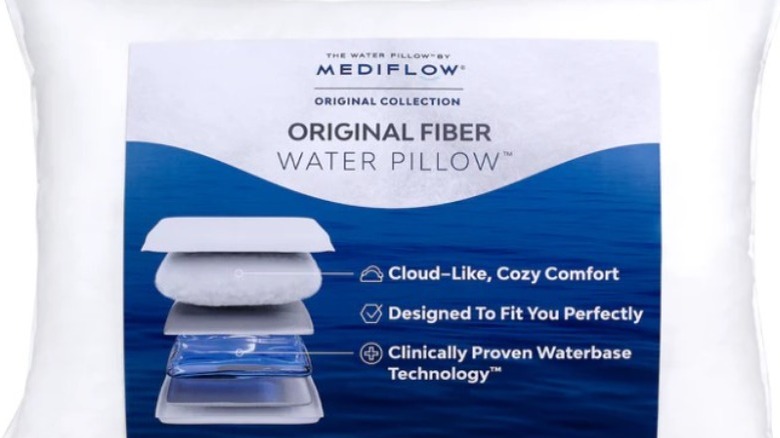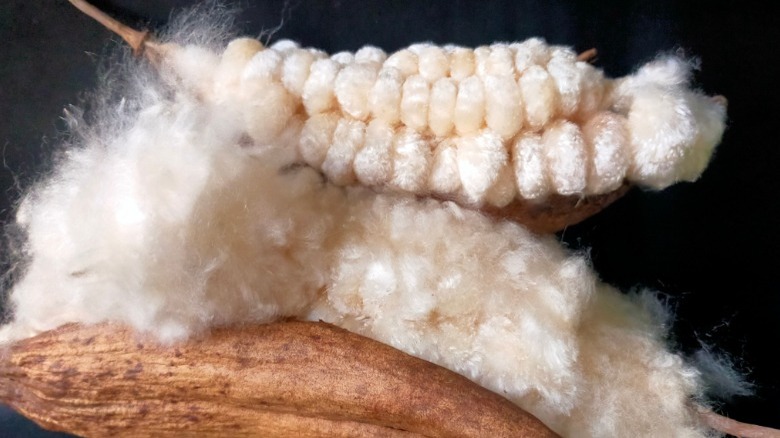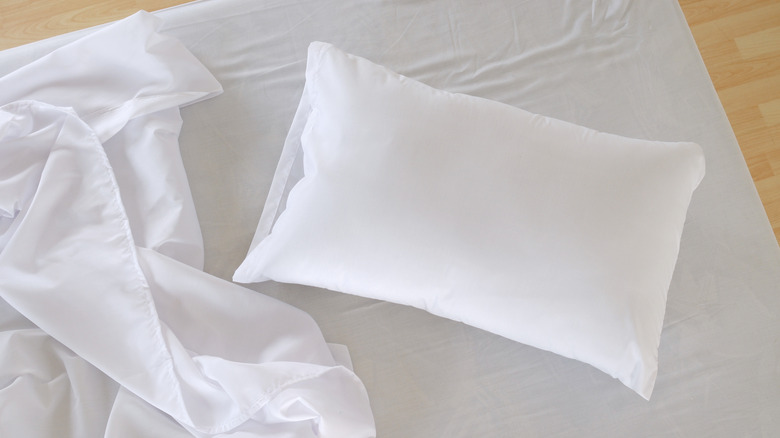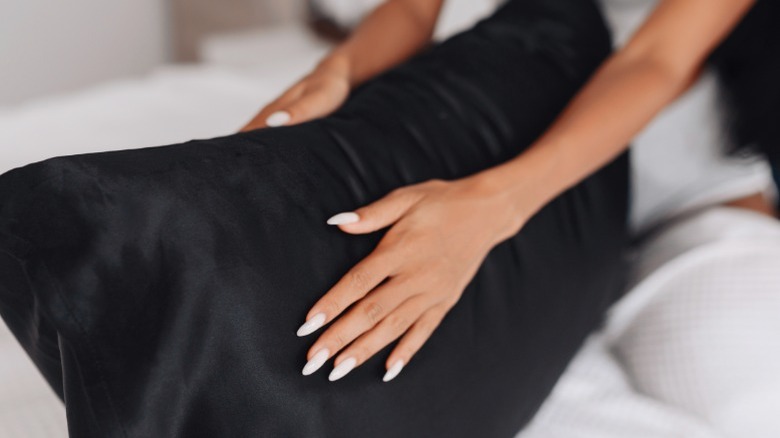How To Care For And Clean Your Bed Pillows
You spend hours with them almost every night, so don't they deserve a little love? Yes, we're talking about your bed pillows. They have to be replaced eventually, but if you keep them cleaned and protected, they can last longer, retain their shape, and smell a whole lot better. The appropriate cleaning methods depend on the pillow type. Consumer Reports show that polyester and memory foam pillows are two of the most popular, but the latter is more rigid. Polyester-filled pillows feel cottony but might only last for a short time, and latex pillows are made from natural or synthetic fillers and feel springier. Other choices include down, feather, water-filled, kapok, and buckwheat.
These pillow fillings have their pros and cons. But just like with clothes, you need to know how to properly clean them so they don't lose their shape or have their filling damaged. But have you ever tried to read the tiny print on the manufacturers' labels? Yep, you probably need a magnifying glass. Forget that! Cut the tag off with a pair of scissors (it probably keeps sticking out of the pillowcase, anyway), toss it in the trash, and abide by these tips about caring for and cleaning them.
Cleaning down and feather pillows: they're tougher than you think
Mattress Advisor posts that down pillows can be made from goose, duck, or synthetic down, which is the insulated layer closest to the bird's skin. Down is light and fluffy, whereas feathers are flat and have a stiff quill running through the middle. Because of that, down pillows are softer, fluffier, and better insulated, whereas feather pillows are flatter and firmer. But be aware that while you can buy 100% down-filled pillows, feather pillows usually contain some down.
While these pillows might feel delicate, both can be laundered in washing machines. Peacock Alley recommends removing the pillowcases and checking the pillows for damage first. Use a gentle, low-sudsing laundry detergent in a gentle, warm, or cool water cycle; hot water could damage the pillows. Don't wash a down or feather pillow with other clothing; instead, add another pillow to balance the load. Run a rinse cycle after the first one, and place the pillows between clean, absorbent towels. Press gently (don't wring the pillows), add dryer balls (for fluffing) into your dryer, and dry the pillows on low heat or the air cycle. Stop the dryer a few times to remove the pillows and break up any clumps, and fluff again when they're dry.
How to clean polyester pillows
There's more than one way to wash polyester pillows. Memory Foam Talk recommends checking the pillow surface for spots and using a stain remover product to remove them before laundering. Then, rather than using a washing machine, hand wash it in a sink or bathtub. Use cold water and gentle detergent, submerge the pillows, squeeze out the dirty water, rinse, and repeat.
If you don't want to hand wash them, you can machine-washing polyester pillows on a gentle cycle with a mild detergent. Do not use hot water, even if you are concerned about allergies. Polyester and down alternative pillows can be cleaned similarly. Once these pillows are nice and clean, they can be air-dried outdoors on a nice day or put into the dryer on low heat. These pillows dry faster than other kinds, so check and fluff them every 15 minutes until they are completely dry.
Memory pillows have to be cleaned carefully
Memory foam pillows provide excellent support and are made from solid or shredded foam. Some have cooling materials that resist heat buildup, which is helpful for people who sweat when sleeping. These can also be spot-cleaned, but use caution when washing them. BedPillows.com recommends removing the pillowcases and vacuuming the memory foam once a week, spot-cleaning the pillows once a month, and deep-cleaning them once every two months. Stains can be removed with a gentle detergent, sponge, and water, and allow the pillows to dry before using them again. To remove odors, sprinkle baking soda on the memory foam and let it rest in the sun for two to three hours before vacuuming it with a hose attachment.
Nature's Sleep explains how to wash memory foam pillows in water, stressing that they should never be put in washing machines. When yours needs a deep cleaning, fill up a tub or sink with room-temperature water and add a few drops of mild detergent. Put the pillow in and work it with your hands to gently loosen any dirt or grime. Then, squeeze out the excess water and let the pillow air dry on a flat surface. If it's taking too long, put a fan next to it to speed up the process. You can also dry these pillows in the sun.
Latex pillow cleaning tips
Latex pillows are dense like memory foam but softer and bouncier. Latex also costs more, responds faster to pressure, and resists mildew. It can be natural or synthetic, while memory foam is only synthetic. Latex was originally a natural foam that came from rubber trees, but today's synthetic versions are styrene-butadiene rubber.
According to The Spinery, Rule #1 with latex pillows is to never put them in washers or dryers because both can damage the foam; a dryer's heat could even melt it. To remove spots, dab away any excess surface moisture and poke at the stains with a clean cloth dampened with isopropyl alcohol. Do this before washing the pillow since soap and water will remove the strong smell.
Like memory foam pillows, latex ones are cleaned in tubs and sinks with gentle detergents, but with cold instead of lukewarm water. Keep rinsing until there are no bubbles, and press on the pillow to push out the excess liquid. Latex foam absorbs a lot of water so when you're finished pressing down on it, remove the pillow from the water and place it between two dry towels. Continue pressing until the latex feels dry. These pillows should be air-dried but out of the sun. It can take up to 24 hours to dry, so make sure you have a spare pillow before washing yours.
Cleaning buckwheat pillows
No, they're not a new breakfast cereal — buckwheat pillows were first used in Japan and have since gained popularity in other parts of the globe. Sleep Foundation explains that these fully adjustable pillows contain real buckwheat hulls, and feel like beanbags. The hulls can be added or removed as needed and regulate temperature through consistent airflow. They are naturally firm and moldable, and since they're made with natural ingredients, you don't have to worry about chemicals leeching into your bedding. They can be noisy when they get moved around though, so that can take some getting used to.
Wondering how to clean these oversized beanbags? We got you. ComfyComfy explains that buckwheat hulls should not get wet, but the covers they're enclosed in are washable. You can open the cover, pour the hulls into a clean pillowcase, and keep them there while the dirty cover gets washed. Wet buckwheat hulls are not a good thing, so they should be thrown out and replaced. Slightly damp ones can be spread out in containers and air-dried in the sun. This can also be done once or twice a year to refresh them. Just remember to keep children and pets away so they don't get eaten. These pillows can last up to 10 years, and if you need replacement hulls, Amazon sells a two-pound bag of organic ones for less than $20.
Washing water pillows
Waterbeds were popular back in the 1980s but later suffered the same fate as wall telephones and fax machines — they' became obsolete. But now there are water pillows. While they aren't large enough for an entire human body, they offer some of the same benefits as those outdated mattresses.
Hullo explains that water pillows have interior plastic pouches that are surrounded by down alternative or poly-foam material, so there is a barrier between the water reservoir and the pillow's coverings. Vive Health recommends changing the water every six months, and you can remove the pouch and wipe it down with a clean, damp cloth. To avoid creating mildew, the pouch should be completely dry before it's used again. You can wash the pillow cover separately — these are often made from cotton and can be cleaned in washers or by hand.
Cleaning kapok pillows
Savvy Rest claims that kapok pillows are luxuriously fluffy like down and feather pillows, but since they are sourced from trees, no geese are ever harmed in the manufacturing process. And if your kapok pillow feels overstuffed, you can just remove some of the material.
Like buckwheat and water pillows, kapok pillows have interior casings that hold the filling. Kapok Shop claims that the fibers resist dust mites and dirt, so they don't have to be hand-washed or placed in the washer and dryer. But if the pillow needs a good freshening up, remove the kapok and leave it in a safe, dry area. Make sure that it's all out, and zip up the cover. NSleep suggests washing the cover at 104 degrees Fahrenheit with a gentle detergent. Don't add fabric softeners, and dry it on low heat or put it out in the sun.
Use pillow protectors
These aren't the same as pillowcases; they provide an extra barrier and go under pillowcases to keep pillows lasting longer. Marriott Bonvoy Boutiques explains that pillow protectors are usually made from cotton and are machine-washable, but yours might be different. The naked pillow fits right inside, and the protectors get zipped up around them. These have to be the same size as your pillow, so don't buy a standard-sized one for a queen pillow and so forth.
Pillow protectors differ from pillowcases mainly because of those zippers. The added layer also guards pillows against sweat, dirt, bacteria, and stains, and keeps them nice and fresh. And if you spent a lot of money on a pillow, a protector will safeguard your investment.
Achoo! Allergy shows that allergy pillow covers are made with materials that resist dust mite allergens and pet dander, so these do double duty; dirt and sneezing/runny nose protection. You can clean pillow protectors three times a year, but feel free to do it more often if they become stained or you don't use pillowcases on top of them.
Always use pillowcases
While you might see naked pillows without pillowcases on top of a dorm room, frat house, or bachelor pad bed, this situation is inappropriate for grownups. The Daily Bed discusses the importance of using pillowcases, pointing out that these open-ended fabric envelopes shield their contents from sweat, spills, and drool. Not only that, if you lotion up or use hair products, the oils will get into your pillows and leave stains and smells. They also protect pillows from dust mites and other allergens.
Uncovered pillows won't last as long without coverings, so you may need to buy new ones more often. Cases are made from different materials like cotton and polyester, which tend to feel better against the skin than an uncovered pillow. You should aim to wash your pillowcases once a week and while you're at it, wash your sheets and any other bedding that is in direct contact with your skin. Shake them all out after removing them from the washer, as this helps them dry more evenly in the dryer.
WebMD recommends cleaning pillows twice a year if you don't have pets; otherwise, four times a year will be sufficient if you use pillow covers and/or pillowcases. If your pillows are unprotected, you might want to wash them once a week.
